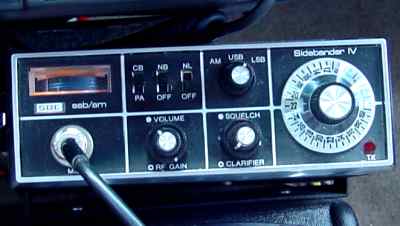


The period between 1976 and 1978 was a strange transition for most CB radio manufacturers - The US Government (FCC) had allowed for the addition of 17 extra channels, expanding the band from 23 to 40 channels. At the same time, they mandated that 23 channel rigs could no longer be offered for sale after a certain date, which caused a mass sellout and discount of the older 23 channel radios. During the time period of uncertainty, many retro-fitted rigs were on put on the market, equipped with 40channel mechanical channel selectors, trying to buy them time while they ran up production of the newer digital display models.
The SBE (Sideband Engineers) "Sidebander IV" is a fairly compact mobile (larger than a PC-122 but smaller than the Grant/148GTL footprint) with a minimum of "Flash", yet well equipped with the standard features that everyone needs on a day-2-day basis.
The front panel is cleanly designed, with a CB/PA switch, NB and ANL switch, and mode selector completing the top of the panel. Along the bottom, are 2 control knobs, each with an inner and outer function (thus accounting for the smaller size). The volume / RF control is on the left, and the Clarifier/Squelch control on the right. Finally, the channel selector is on the right side, with a small red LED Tx indicator in the lower right corner.
The channel selector is the weakest feature of this radio, as it's hard to read (40 channels scrunched onto a 23ch-sized selector), but after some use, I got back to the olden days, of remembering what channel I started on, then counting up or down as I heard each "CLICK".

What I liked about this radio :
As most of you know by now (if you've read any of my reviews), my continuing never-ending-theme-pet-peeve is Adjacent channel rejection (or lack of). I'm happy to say that this little rig is GREAT and I've had little problems reading the mail, while driving down I-10. The receiver seems to be as sensitive as most others I've used, and my 2nd most pet-peeve (Noise-blanking) was happily surprised to find a very nice noise blanker! I didn't pop the PLL cover off this puppy, nor could I find a listing in SAMS for this particular model, so I'm not sure WHO really made this little gem.
Transmit audio reports were good, using SBE's amplified hand microphone (it looks the same as their stock mike, only a little larger). I would typically throw a +3 or D-104M microphone on this, but I guess I'm getting lazy in my old age and have yet to feel like soldering one up.
What I didn't like about this radio:
The a fore mentioned channel selector was difficult to read, and lemme tell ya, if that light burns out behind the selector it's a bugger to replace. Lastly, while not a specific complaint (merely a preference) I wish the Squelch and Clarifier controls were swapped. I rarely (if at all) use the squelch control and having the clarifier 1/2" closer would have made clarifying and driving a less threatening experience.
Summary:
As I stated in the beginning of this review, this radio fell short of "perfect" status in this decade, mainly due to the channel selector. However, in the year this radio was manufactured, I would have put it up against of it's competitors. Suffice to say - this rig is still being used in the Woodymobile.